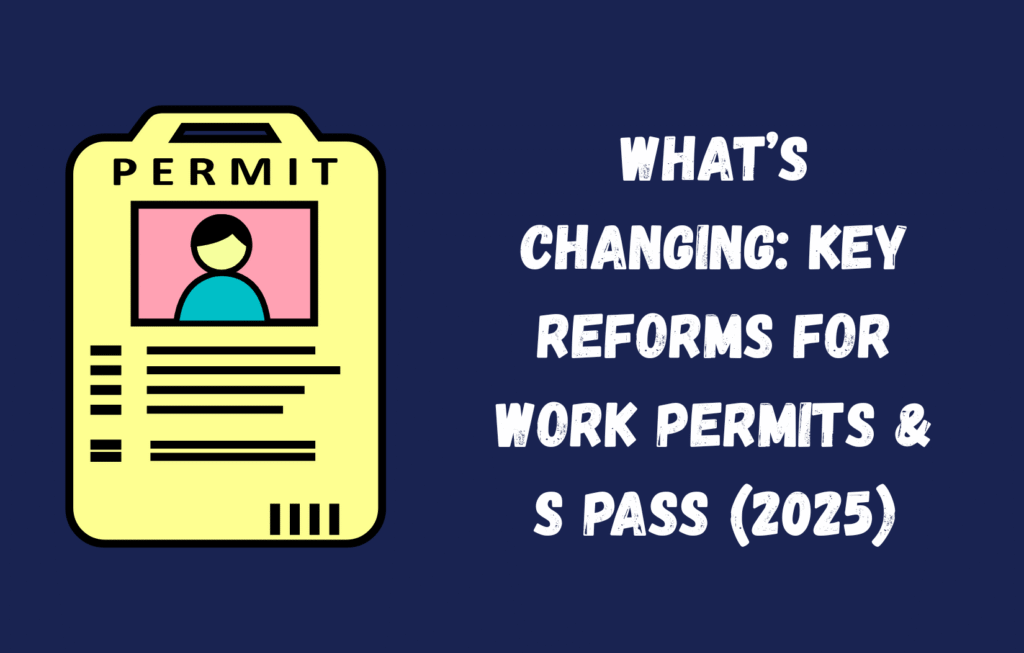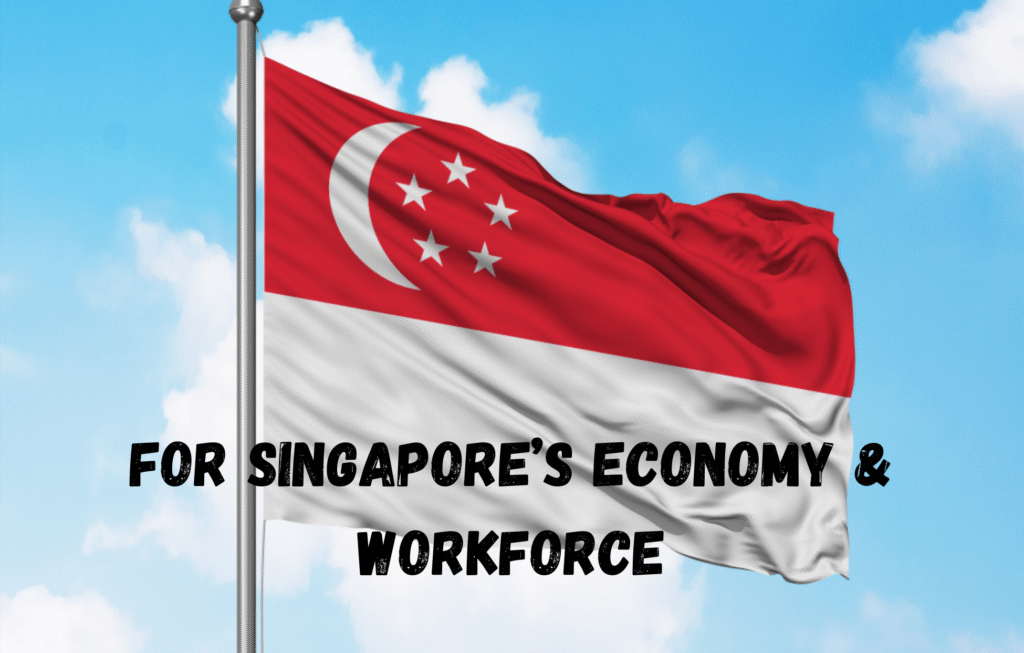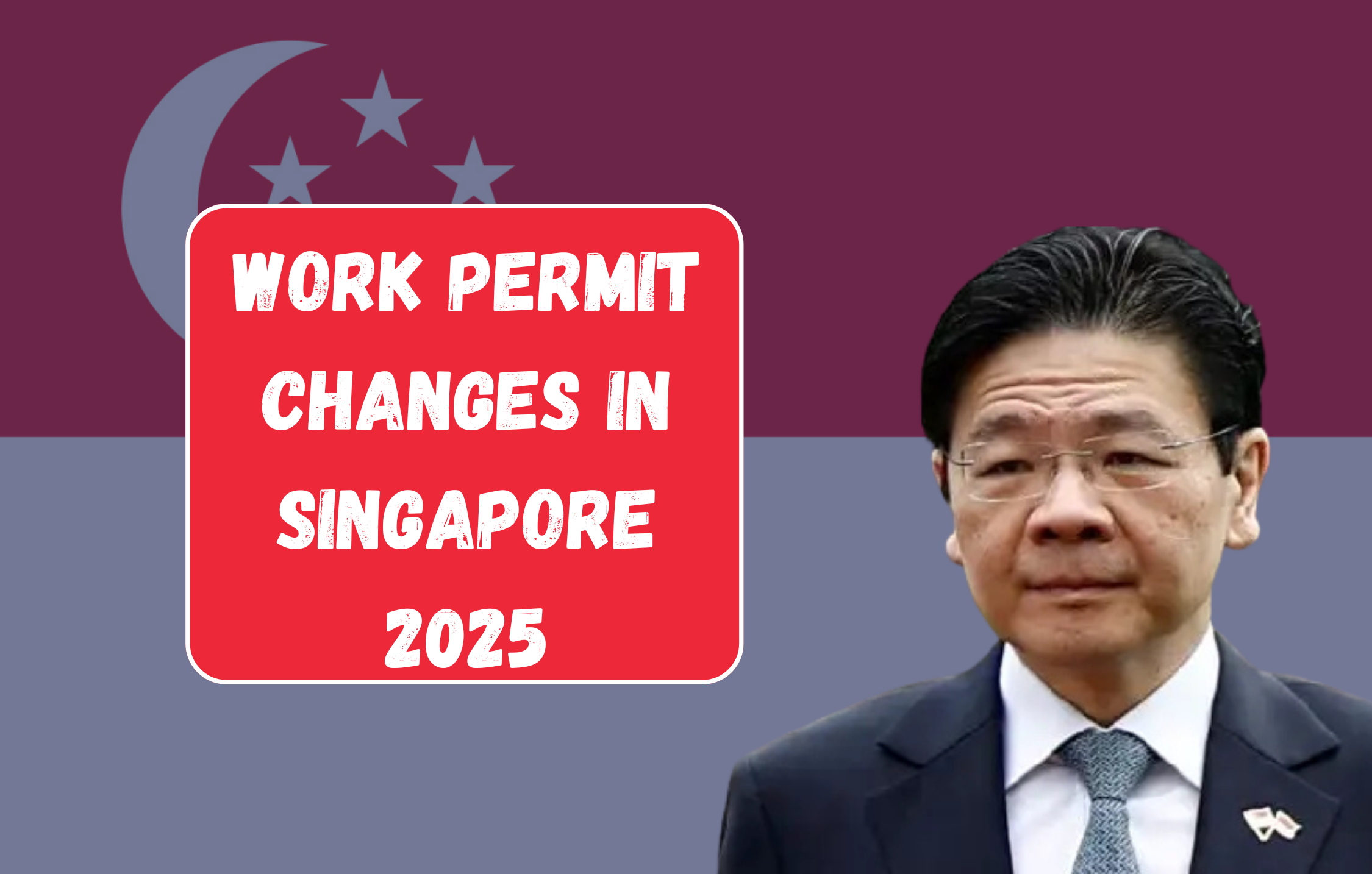Singapore Work Permit New Changes: Check New Eligibility & Application Process
Introduction: Why Singapore Is Reforming the Work Permit Regime
In 2025, Singapore’s Ministry of Manpower (MOM) is rolling out one of its most significant overhauls of work pass and foreign worker policies in recent years. The changes are designed to help firms retain experienced foreign workers, address persistent labor shortages in key sectors, raise hiring standards, and better align foreign workforce rules with Singapore’s long‑term economic goals.
Among the headline reforms, the cap on how long a Work Permit holder can stay employed is being removed, the maximum employment age is being raised, the list of permissible source countries and occupations is being expanded, and S Pass salary thresholds and levy rates are being adjusted. These changes begin in stages from July through September 2025.
Below is a full breakdown: what’s changing, new eligibility rules, how application and renewal processes will work, and practical advice for employers and jobseekers.
What’s Changing: Key Reforms for Work Permits & S Pass (2025)

1. Removal of Maximum Employment Duration for Work Permit Holders
Effective 1 July 2025, the hard cap on how many years a Work Permit holder could stay employed is abolished. Previously, depending on the sector, skill level, and nationality, the cap ranged between 14 and 26 years. With this removal, as long as eligibility criteria are met and the employer still has need for them, Work Permit holders can be retained indefinitely (except for migrant domestic workers, which use a different regime). This is intended to reduce turnover, allow firms to retain experienced rank‑and‑file workers, and lower replacement/training costs.
2. Raise in Maximum Employment Age & Application Age Limit
The maximum employment age for Work Permit holders will be increased from 60 to 63 to align with Singapore’s retirement age. For new Work Permit applications, the age cap will be pegged at 61 years old (i.e. two years below the employment ceiling).
Prior to this, non‑Malaysian applicants needed to be under 50 years old; Malaysians under 58. These thresholds will change under the new regime. These age reforms mean that experienced foreign workers nearing retirement will now have extended tenure and a window for new applications that accommodates older talent.
3. Expansion of Source Countries & Non‑Traditional Sources (NTS) Occupation List
From 1 June 2025, Bhutan, Cambodia, and Laos will be added to the list of non‑traditional source (NTS) countries from which firms can hire Work Permit holders in services or manufacturing sectors. From 1 September 2025, the NTS Occupation List (the list of allowed roles for those non-traditional source workers) will expand to include heavy vehicle drivers, various manufacturing operators, and cooks (not limited to a specific cuisine).
The NTS scheme requires that such workers be paid at least S$2,000 per month, and firms must maintain the sub-dependency ratio (i.e. NTS workers should comprise at most 8% of the employer’s workforce, excluding Employment Pass holders). By opening up more countries and job roles, the reforms give employers more flexibility to fill manpower gaps.
4. Changes to S Pass Salary Thresholds and Levy Rates
While the above changes center on Work Permits, there are attendant changes for S Pass holders (a middle-tier pass for mid-skilled workers):
From 1 September 2025, the minimum qualifying salary for S Pass holders (non‑financial sectors) will be raised from S$3,150 to S$3,300. For the financial services sector, the S Pass minimum salary will increase from S$3,650 to S$3,800.
The Tier 1 levy for S Pass holders will increase from S$550 to S$650 per month, starting September 2025. The S Pass changes will apply to new applications from 1 September 2025, and to renewals of passes expiring on or after 1 September 2026. These adjustments aim to ensure S Pass holders are compensated at more competitive levels and to ensure quality of hire.
5. Extension of M‑SEP (Manpower for Strategic Economic Priorities) Duration
The M‑SEP scheme, which allows certain firms to temporarily exceed foreign worker quotas, will see its approval period extended from two years to three years from 1 May 2025 onward. Additionally, there will be more flexibility in meeting its qualifying criteria. This gives firms more leeway in sectors crucial to strategic transformation.
New Eligibility & Application / Renewal Process

With these changes, eligibility criteria and application processes will also adjust. Here’s what to expect:
Work Permit (for Rank‑and‑File / PMET‑Light Roles)
Eligibility under the new rules:
- Must be applying for a role permitted under the Work Permit framework (non‑PMET, rank‑and‑file, or roles in services/manufacturing)
- The applicant’s age must be ≤ 61 at the time of application
- The employing company must meet quota and other prerequisites
- For hiring from non-traditional sources, the role must be on the expanded NTS Occupation List and the salary floor of S$2,000 must be satisfied
- The foreign worker must satisfy MOM’s medical, character and clearance criteria
- The firm must comply with all foreign worker regulations (e.g. dormitories, welfare, insurance, etc.)
Application & Renewal Process:
- Employers will continue to apply via MOM’s online system for Work Permits — the process remains digital, though MOM may increase scrutiny on submitted documents
- When renewing, applicants must still meet the adjusted maximum age (max age becomes 63) and satisfy ongoing eligibility (e.g. firm’s quota, role necessity)
- For non-traditional source roles, the employer must show that the role is covered under NTS and pay the required salary floor
- Employers should anticipate more frequent audits or checks, especially during the transition
- Because the employment duration cap is removed, renewal decisions will likely focus more on firm needs and performance rather than expiration of maximum tenure
S Pass (Mid-level Skilled Workers)
Eligibility:
- Applicants must meet the revised salary thresholds (S$3,300 for most sectors, S$3,800 for financial services)
- In addition to salary, the usual COMPASS assessment (which weighs qualifications, job function, firm’s economic contributions) remains relevant
- Age and quota constraints still apply
- For renewals of S Passes expiring from 1 September 2026 onward, the new thresholds will be enforced
Application Process:
- From 1 September 2025, employers must use MOM’s updated application portal under the revised rules
- Employers will need to factor in the higher levy cost (Tier 1 levy rising to S$650) when budgeting
- Applications failing to meet the new salary/levy requirements will likely be rejected
- Employers should reassess current S Pass holders and plan ahead for upcoming renewals under the new regime
Implications & What Stakeholders Need to Prepare
These reforms carry a number of consequences for employers, foreign workers, and the broader labor market.
For Employers & HR Teams
- You can retain experienced foreign workers longer without worrying about tenure caps
- Age constraints are eased, allowing hiring or retaining older workers
- The expansion of NTS roles broadens your hiring pool (e.g. some cooks, heavy vehicle drivers, manufacturing operators)
- However, costs may rise: S Pass levies increase, and salary floors must be respected
- You will need to review workforce plans, especially for staff nearing prior tenure caps
- You may face higher regulatory scrutiny in applications, audits, and compliance checks
- Use the extended M‑SEP flexibility for strategic hiring in transformative sectors
For Foreign Workers / Job Seekers
- Greater job security: once hired, Work Permit holders (outside domestic work) won’t be forced out just due to duration limits
- Older applicants (up to age 61) now have entry eligibility; existing workers may continue until 63
- Those from newly eligible countries (Bhutan, Cambodia, Laos) and in newly permitted roles now have expanded opportunities
- But for S Pass applicants, you must ensure your salary and credentials meet the raised thresholds
- Be aware of renewal timing: your pass renewal after 1 September 2026 may be subject to stricter criteria
For Singapore’s Economy & Workforce

- These reforms aim to reduce costly turnover, strengthen workforce continuity, and allow firms to retain institutional knowledge
- They may ease manpower pressures in sectors with chronic labor shortages
- However, the balance of protecting local employment and maintaining foreign flexibility is delicate — MOM will likely monitor market impacts closely
- The changes further signal Singapore’s intention to remain competitive in attracting and retaining foreign salaried workers while ensuring quality and fair practices
Practical Tips & Checklist for Navigating the New Regime
- Audit your current foreign workforce
- Identify employees near former tenure limits
- Flag those nearing age constraints
- Adjust retention plans given the removal of caps
- Review upcoming S Pass renewals
- Check whether current holders meet the new salary and levy criteria
- Prepare for increased levy costs
- Reassess whether some roles may fall better under updated Work Permit/NTS rules
- Plan recruitments in newly expanded roles/countries
- For roles like cooks, drivers, operators, consider sourcing from newly eligible countries
- Ensure role is listed under NTS occupation list after September 2025
- Budget for higher costs
- Include increased S Pass levy (Tier 1 → S$650)
- Factor in possible wage adjustments for NTS hires
- Incorporate compliance costs, audits, etc.
- Stay compliant on documents and approvals
- Maintain
clear records of eligibility
- Update workflows to include checks under the new rules
- Anticipate more rigorous MOM reviews in initial years
- Time renewals wisely
- Try to renew S Passes before the new thresholds hit, if possible
- For Work Permit holders, ensure renewal falls before hitting new age ceiling
- Communicate with staff
- Explain to foreign hires what changes mean (more certainty, possibly longer tenure)
- Manage expectations around salary or role changes
- Consult experts or MOM guidelines
- Use official MOM resources and updated policy documents
- Seek legal or HR advisory help if necessary
Summary
- Singapore’s Work Permit regime is undergoing sweeping changes in 2025 to remove duration caps, raise employment age, expand eligible source countries and roles, and tighten S Pass passes.
- From 1 July 2025, Work Permit holders no longer have fixed tenure limits, and their employment age limit is raised to 63. For new Work Permit applications, the age limit is 61.
- From 1 June 2025, Bhutan, Cambodia, and Laos become added source countries. From 1 September 2025, new roles (heavy vehicle drivers, manufacturing, cooks) are included in the NTS schedule.
- S Pass requirements will also shift: minimum salary thresholds increase and the Tier 1 levy jumps to S$650/month.
- Application and renewal processes remain digital, but scrutiny may increase under the new framework.
- Employers must reassess workforce strategy, budget for higher costs, and take advantage of the retention benefits. Foreign workers benefit from higher stability and extended employment opportunities — though meeting S Pass thresholds remains critical.
FAQs
1. What is the biggest change to Work Permits in 2025?
The fixed maximum employment duration for Work Permit holders is removed from July 1, 2025, allowing eligible foreign workers to stay employed indefinitely, subject to renewal criteria.
2. What is the new maximum age for Work Permit holders?
From 2025, Work Permit holders can work up to age 63. New applicants must be 61 or younger at the time of application under the revised MOM rules.
3. Can I still apply for a Work Permit if I’m over 50?
Yes. Starting July 2025, applicants up to age 61 can apply, replacing previous stricter age limits (50 for non-Malaysians, 58 for Malaysians).
